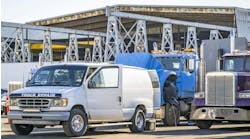Fontana: Leveraging telematics data to improve driver safety and efficiency
Drivers play a big role in the efficiency, profitability, and safety of a fleet. By some estimates, drivers can influence a truck’s fuel efficiency by as much as 30% based on how they operate the vehicle.
According to the U.S. Energy Information Administration, for the week of March 11, diesel fuel was averaging $4.004 per gallon. That was down -0.243 from a year ago. But as all of us in the trucking industry know, fuel prices can be volatile depending on various factors, most of which are outside our control. Regardless of the price, fuel accounted for 28% of a fleet’s total average marginal costs in 2022, according to the American Transportation Research Institute’s An Analysis of the Operational Cost of Trucking: 2023 Update.
In my most recent blog, I discussed the benefits of dashcams and in-cab videos for enhancing safety and driver coaching. In addition to data from the cameras, fleet managers can also leverage data from telematics devices for driver improvement.
Telematics devices can also be used to monitor things like exceeding the speed limit, hard braking, and fast accelerations. The devices can be programmed to capture all of those driving behaviors, and fleet managers have access to all of this information.
As any member of my team will tell you, I remind them that CSA violations are the things that drivers “got caught” doing. Telematics data, specifically showing speeding, is the data they were able to conceal. Although there could be a valid reason for a short-duration speeding event, when using parameters such as “how much over the limit and for how long,” it’s easy to weed out valid reasons from something the driver didn’t “get caught” doing. Those are perfect coaching opportunities.
Having the specific data from the telematics devices takes the coaching conversations out of the theoretical realm straight into reality. Telematics will pinpoint the exact time and location where speeding or hard braking occurred. Concrete information allows for better coaching and takes some of the emotion out of the coaching sessions.
See also: Improving uptime: How diagnostics and telematics create comprehensive maintenance plans
Managers need to remember that the best use of the data is for coaching that leads to driver improvement, not punishment. The goal is for drivers to become more aware of the way they drive and concentrate on driving safely and efficiently. It is possible that some drivers may not be aware of some of their behaviors, especially when it comes to exceeding the speed limit.
Like camera data, telematics data can also be used to recognize and reward drivers who engage in the behaviors you desire. And while you coach in private, I encourage you to recognize and reward in a very public way. Make sure the “best” drivers are being lauded because this can serve as an incentive for other drivers to step up their game. Throughout my years in trucking, I have found drivers to be a pretty competitive group, and signaling out your top drivers can ignite the competitive spirit in other drivers who will then become more mindful of how they are driving.
Today’s fleet managers have a wealth of data at their fingertips that, when used correctly, can lead to safer, more efficient operations.



